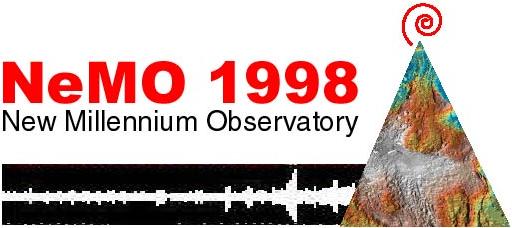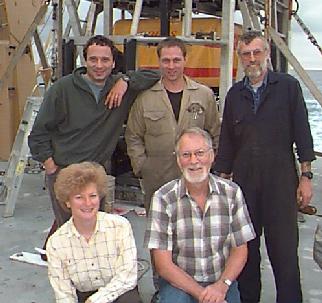WHAT'S NEW:
Deepsea Image Galleries on Multimedia page
(posted 9/15/98)
Eruption Confirmed!
New lava (rumbleometer stuck in flow) SE rift zone
(posted 9/1/98)
BACKGROUND:
Technology (ROV, ships, etc.)
Other 1998 Axial cruise reports
EXPEDITION:
Science Objectives
Calendar
Today's Science News
Participant Perspective
Teacher Logbook
EDUCATION:
Curriculum
Teacher Observations
Questions/Answers from sea
MULTIMEDIA:
(video clips, animations, sounds)

Logbook
September 19, 1998
September 19, 1998
Contents:
Science Report
Listing of all Science News postings
Life at Sea: Participant Perspective
Susan Merle
OSU/NOAA Vents Program, Newport Oregon

Hi! My name is Susan Merle. I'm a geological oceanographer. For the last year it has been my pleasure to work as Bob Embley's research assistant at in Newport Oregon. I'm employed by Oregon State University, working with NOAA/PMEL in the VENTS program.
I have been working in my field for the last seven years. I was a late bloomer, it's never too late to get that degree. Most of my career was spent in the commercial field working for a seafloor survey company in Seattle, processing sidescan sonar data. I spent quite a lot of time at sea (more than 20 cruises) doing fibre-optic cable surveys, pipeline surveys, etc. while working out of Seattle. That job allowed me to travel extensively out of the country on foreign vessels, with foreign crews. The cultural experiences were irreplaceable. The travel was exciting though over the years my wanderlust ebbed, so when I heard there was an opening at Hatfield I decided it was time for a change. I haven't looked back.
Working with a great group of dedicated scientists in the VENTS program has been a fulfilling experience. I particularly enjoy being able to "do science" again, and feel I am constantly learning new things on the job. I'm thankful to Bob Embley and Bill Chadwick for their patience with me as I've tried to catch up on all the exciting work we do. My job is never boring. I perform a wide variety of tasks such as: bathymetric and sidescan sonar mapping, working on figures for publications, making poster for presentations, working with video data, and learning how to operate the SeaBeam multibeam sonar system. Gene Williamson and myself are also working with Andra Bobbitt at Hatfield to bring you the NeMO website.
Which brings me to the NeMO98 cruise. This is my first submersible cruise and ROPOS has been amazing. While sitting in front of the navigation computer trying to figure out where the sub is, I've seen some incredible sights ranging from black smokers to diffuse vents, and all the animals associated with these vent communities. One truly feels like they are right there in the caldera with the sub. Absolutely the most incredible cruise I've been on. Combine the exciting work, a group of dedicated scientists for colleagues, and the pleasure of living on the beautiful Oregon Coast, and I must say I've got it good. I'm hoping the VENTS program continues for many years to come.
Listing of all Perspectives postings
Teacher At Sea Logbook
September 19- 0900 hours

We are underway, bound for Victoria. We managed to get our last dive in late yesterday. The extensometers were positioned on the ocean floor and we had one last chance to visit the site at CASM (Canadian-American Sea Mount) where all of this began a decade and a half ago with the discovery of the first hot vents in the North Pacific. The three scientists and two Pisces pilots who were involved in that discovery are reunited on this cruise. (photo left: l-r, top: Kim Juniper, Keith Shepherd, Bob Holland, bottom: Verena Tunnicliffe, and Steve Scott) There were many changes at CASM compared to the first visit. Many dead tube worms littered the site, but other life forms were doing very well. One of the largest populations of palm worms yet discovered was seen. One of the big questions for biologists is how these vents become populated in the first place, and once they are, how does the population change over time? The ability to visit a site over a period of time will help to answer questions like these. That is the idea behind establishing a true observatory at Axial Seamount.
The truth is that while scientists have begun to answer some of the questions about the geology, chemistry, and biology of the vent systems, they may have created more questions than they answered. Despite a month of intensive observation, the scientists are asking questions, not giving answers. Not yet anyway. All of the data will have to be sifted and allowed to settle before answers will begin to appear, but along with answers that do occur will come the questions that could well form the focus of the next visit to the observatory.
Some will ask where the benefit lies in all of this for the Canadian or American tax-payer. No one has a specific ready answer for that. We do have an ore geologist on board. There is strong evidence to indicate that old ridge systems may be the source of rich ore deposits. The fact is that we all benefit in ways we cannot foresee. Freeze-dried foods and the plastic used in football helmets and the light covers on your car's turn signals came out of the American space program. What is found and what use humans make of it will be the product of those well-schooled human minds at work out here and on shore.
Today is major clean-up, pack-up and tie-down day. Video tapes are being put in order, computers torn down and boxed, and scientific equipment carefully packed away until the next voyage. I want to pick up where I left off yesterday to remind you briefly of the outstanding people I have met and the projects on which they are working. I know that some of the scientists on board have not received a fair share of coverage on the web page. Whether I failed to comprehend the complex work they are doing, or worked a different watch or in a different part of the ship, the fault is mine. The work that they are doing is just as important and as impressive as are the projects that have received more coverage. Sometimes it just came down to who was sitting across the table at dinner.
It was a real pleasure to watch scientists from Canada and United States working together, in part erasing the political differences that occasionally arise between these two great nations. ROPOS is Canadian, as are the technicians who have kept this platform operating throughout the past month. There are also three Canadian scientists on board without whom this expedition and this website would not, could not, have been as successful as they were. Kim Juniper of the University of Quebec at Montreal, with the help of his graduate students, has been responsible for much of the biological work with those samples known as "slurp samples." They have also been responsible for much of the technical advice on video records of the voyage. Dr. Juniper has taken time to read my daily reports and show me where improvements could be made. Steve Scott, a geology professor from the University of Toronto, with special expertise in mineral ores, has likewise taken time to give me basic instruction in special topics and make comments on the web page. Steve is one of a group of forward-thinking Canadians who saved ROPOS from the scrap heap a few years back. I have to offer special thanks to Verena Tunnicliffe of the University of Victoria. She not only epitomizes the scientist who is excited by the work she is doing, but she also took special pains to help me to better understand vent biology. Several times she took the questions that came in on the web and wrote concise, understandable answers. I would love to take a class from her at the University. All three of these professors are clearly teachers. All of us who have had the university experience know that this is unfortunately not always true of professors.
I also have to mention to
crew of the Ronald Brown. Everyone on board has done
their utmost to make this cruise work. The folks on deck have handled
deployment and recovery of instruments with great skill. The engineers kept the
ship running smoothly. The stewards have fed us far too well and have kept the
operation ship-shape from top to bottom. From these people I have learned a
little bit about seamanship, how a ship like the Brown operates, and how much
you have to know to be able to do any of their jobs. I have even received a few
tips about the stock market. The captain and officers of the Brown have gone
about their jobs in a way that appears practically seamless in terms of
impacting the work the scientists are doing. Their support has been essential
and appreciated. I want to make special mention of the help I received from Lt.
Alan Hilton, the ship's navigation officer.
With his knowledge of computers and
the web he not only made it easier for me to get my reports and photographs to
the web, but he also got the web pages downloaded to the ship's computers so
that participants could see how the work out here was being represented to the
rest of the world.

This has been the opportunity of a lifetime for me. I cannot conceive of a reason why I should have had the good fortune to be chosen to go to sea on a voyage of discovery this late in my career. I have thoroughly enjoyed the sea, the people, and the excitement of this voyage. I hope that those of you who read these web pages have come away with a better understanding of how and why this kind of research is important. It would be great if some student reading this makes the decision that he or she wants to put out the effort necessary to become one of the next generation of ocean explorers. It would also be great if a teacher makes a decision to contact NOAA and become a part of the Teacher-at-Sea program. It's all out here folks. All you have to do is reach out and take it.
Thank you for visiting the New Millennium Observatory (NeMO) web page. Now get back to your books and get ready for that math quiz tomorrow.
Logbook of all Teacher At Sea postings
Question/Answer of the Day
Send Your Question to NeMO
(oar.pmel.vents.webmaster@noaa.gov)
Back to Calendar